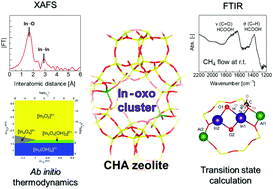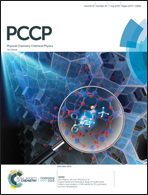Experimental and theoretical study of multinuclear indium–oxo clusters in CHA zeolite for CH4 activation at room temperature†
Abstract
We have carried out an experimental and theoretical study of CHA-zeolite supported indium (In)–oxo clusters that promote CH4 activation at room temperature. X-ray absorption fine structure (XAFS) measurements indicate the formation of multinuclear In–oxo clusters by the O2 activation of the In(I)-exchanged CHA zeolite prepared through reductive solid-state ion exchange (RSSIE). The structure of the In–oxo clusters and their locations were investigated in detail using ab initio thermodynamic analysis. The redox properties of the In species during RSSIE and the formation of the In–oxo clusters were also studied by temperature programmed reaction and in situ XAFS measurements. The reaction of CH4 on the O2-activated In-CHA zeolite was monitored using IR spectroscopy where adsorbed formic acid was generated at room temperature. The adsorption and C–H activation of CH4 on our plausible model of the In–oxo clusters were theoretically investigated using density functional theory calculations. We found that CH4 is likely to adsorb and react more easily on dinuclear In–oxo ions than on monomeric In–oxo ions and that the C–H bond cleavage reaction occurs via a heterolytic pathway rather than a homolytic pathway. This study reveals the potential of multinuclear In–oxo clusters as active sites for the transformation of CH4 to oxygenates under mild reaction conditions.



 Please wait while we load your content...
Please wait while we load your content...
